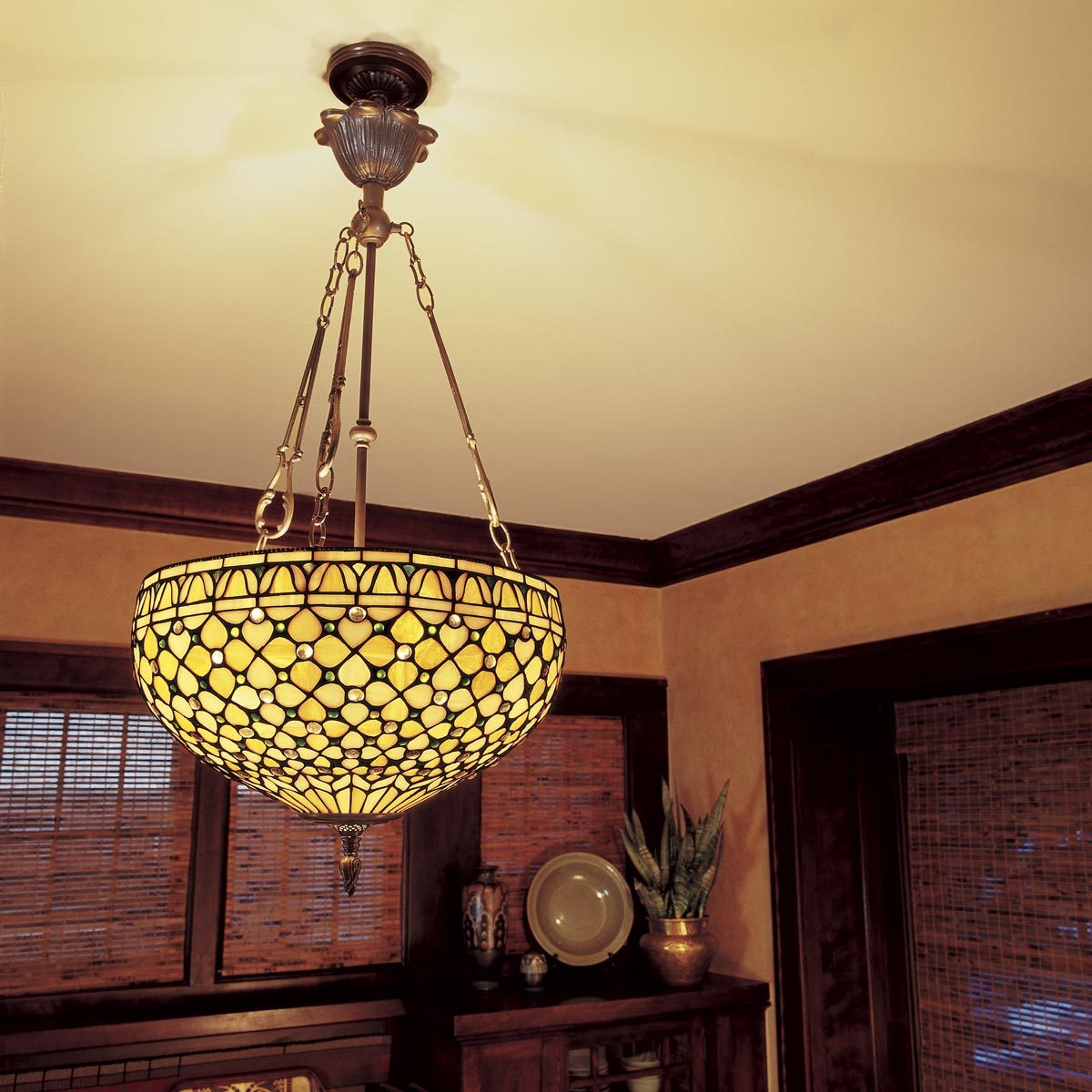Nothing spoils a dinner party like a chandelier in the pasta or a sudden blackout. Here's how to hang lights safely and securely.
A full day
Beginner
Less than $20
Introduction
Change a drab room into a dazzling one with a new overhead light fixture. Here's how to mount that new fixture correctly and safely using professional installation techniques. Even if you've never tackled an electrical project before, you can install a ceiling fixture by following the DIY advice and photos in this story.
How to Hang a Ceiling Light Fixture Project Overview
Installing a new light fixture is a great way to instantly change a drab room into a dazzling one. Lighting showrooms and catalogs have a wide variety of fixtures to tempt you. And even though the bag of parts included with some fixtures may look daunting, the electrical connections are simple enough for someone with a basic understanding of electricity.
But poor installation techniques can result in a potentially lethal shock or fire. In this article, we’ll help you choose a fixture that will mount safely on your electrical box and then show you the best techniques for testing a ground and connecting the wires. We’ve even included photos of the two most common mounting systems to help you make sense of all those little parts.
The temperature rating of your existing wires will affect which type of fixture you can install. Before you go shopping, read more.
Here are a few ways to upgrade light fixtures, so they are more efficient and eco-friendlier.
Tools Required
- 4-in-1 screwdriver
- Needle-nose pliers
- Non-contact voltage tester
- Pliers
- Stepladder
- Voltage tester
- Wire stripper/cutter
Materials Required
- 10-32 ground screw
- Electrical box
- Electrical tape
- Light texture
- Wire nuts
Project step-by-step (9)
Remove the Old Fixture and Inspect the Wiring
Remove the Fixture
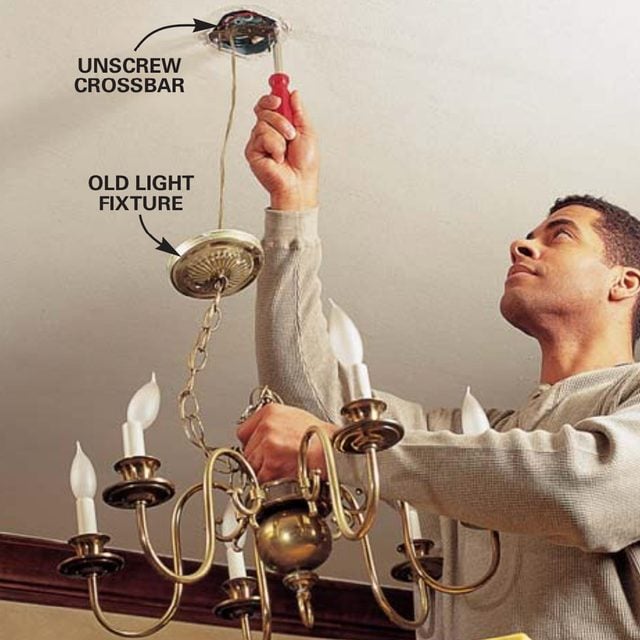
Turn off the power to the light fixture at the main circuit panel. Remove the nut or screws securing the dome-shaped canopy and lower it. Then remove the screws securing the crossbar to the electrical box and lower the fixture.
Make Sure the Power is Off
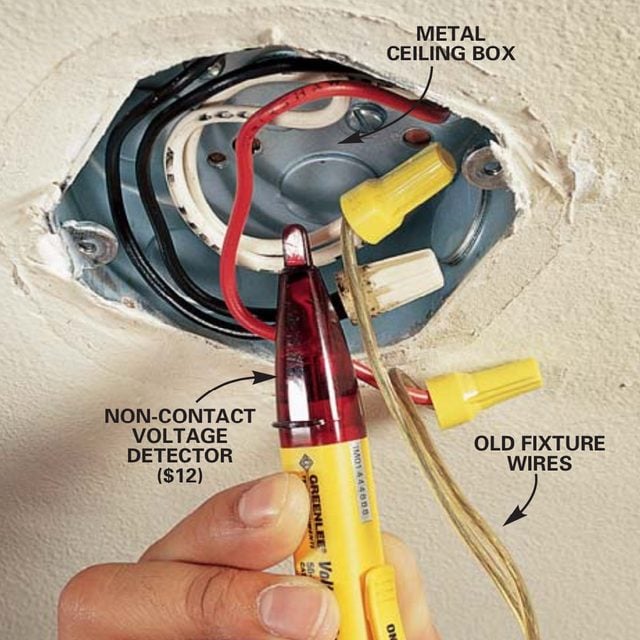
Test the wires to make sure the power is off. Move the tip of a non-contact voltage detector near each wire to make sure the power to all wires in the box is turned off (make sure the light switch is turned on). If the tester lights, switch off circuit breakers or loosen fuses one at a time until the tester light goes off. Disconnect the wires from the light fixture. Leave other wires connected and tucked into the electrical box.
It’s hard to believe, but many of the light fixtures now sold at home centers and lighting showrooms can’t be safely installed in most houses wired before 1985. These fixtures are clearly labeled with a warning that reads “For supply connections, use wire rated for at least 90 degrees C.” The reason is simple: Fixtures with this label generate enough heat to damage the insulation on older wires and cause a fire hazard. Wires manufactured after 1985 are required to have coverings that can withstand the higher temperature.
If you know your wiring was installed before 1985, don’t use fixtures requiring 90-degree–rated supply wires. To confirm that you have 90-degree–rated supply wire, look at the cable jacket or wire insulation. If you have plastic sheathed cable (often referred to as Romex), look for the letters NM-B or UF-B printed on the plastic sheath. If your wiring is fed through conduit, look on the wire insulation for the letters THHN or THWN-2. If you’re still unsure, either call an electrician or choose a fixture that isn’t labeled with a supply wire temperature requirement.
Check the Electrical Box for Capacity and Strength
Heavy Fixtures Require Strong Boxes
If you choose a heavy light fixture (the one we bought weighed in at a hefty 25 lbs.), check your electrical box to make sure it will support the weight. The National Electrical Code (NEC) allows you to hang up to 50 lbs. from any electrical box that is threaded to accept No. 8-32 machine screws for attaching the crossbar (see “Mounting with Screws and Cap Nuts” and “Mounting with a Threaded Pipe” in Additional Information below). This includes almost every type of ceiling box.
For practical purposes, make sure your electrical box is securely fastened to solid framing before you hang a new light fixture from it. If your light fixture weighs more than 50 lbs., it has to be supported independent of the electrical box. An easy solution is to install a fan brace box (available from home centers and hardware stores) that’s designed to be installed without cutting any additional holes in your ceiling. Check the label to make sure the box is designed to support more than 35 lbs.
Most ceiling boxes are large enough: The NEC dictates how many wires and clamps you can safely put in an electrical box. Typical 1-1/2 to 2-in. deep octagonal or round ceiling boxes are quite large and overcrowding is rarely a problem. Even so, you should run through the calculations to be sure. See the section on “Calculating Box Sizes.” But if you encounter a round box that’s only 1/2 in. deep, replace it. Once again, the easiest way to install a new electrical box in an existing ceiling is to use a special fan brace and box made for retrofitting.
Calculating Box Sizes
To figure the minimum box size required by the National Electrical Code, add: 1 for each hot and neutral wire entering the box, 1 for all the ground wires combined, 1 for all the clamps combined, and 2 for each device (switch or receptacle, but usually not light fixtures) installed in the box. Multiply this figure by 2 for 14-gauge wire and 2.25 for 12-gauge wire to get the minimum box volume in cubic inches. Plastic boxes have the volume stamped inside.
Test for a Ground Wire
Turn the Power on and Test for Hot
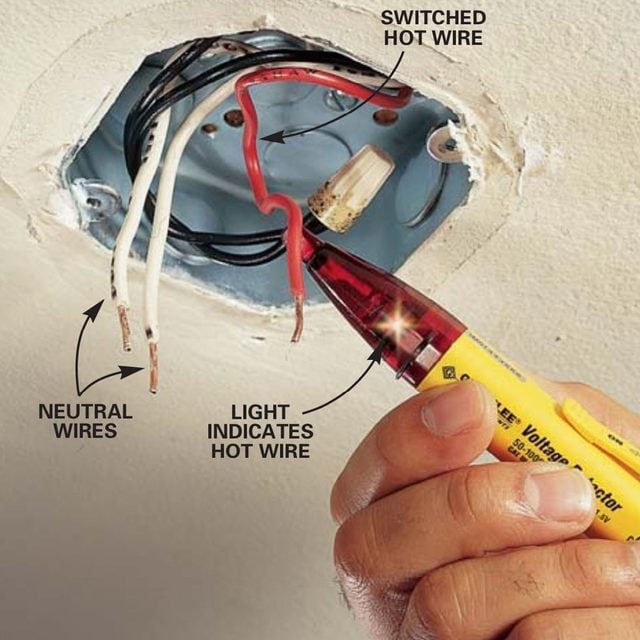
Turn the power to the light back on at the main circuit panel (the light switch is still on). Use the non-contact tester again to make sure there is power to the colored (hot) wire.
Test for Ground
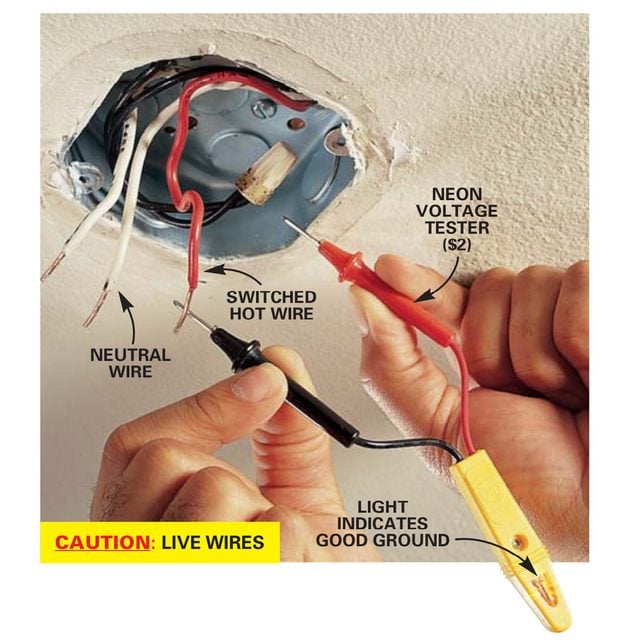
Touch the leads of a neon voltage tester between the hot wire and the metal box (or between the hot wire and bare copper ground wire if you have one). If the tester lights, the metal box or bare copper wire is grounded and you can proceed. If the tester doesn’t light, indicating there is no ground, call in a licensed electrician to supply one. (It’s often difficult.) Turn off the power at the main circuit panel before continuing.
Add a Ground Wire to a Metal Box
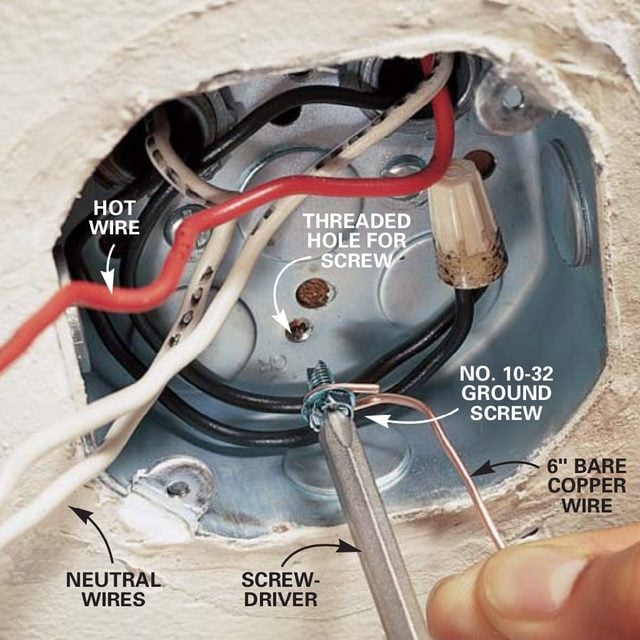
Attach a ground wire to the metal box if it’s not already present (turn power off first). Wrap the end of a 6-in. length of bare copper wire around a No. 10-32 ground screw and drive it into the threaded hole in the bottom of the box. Wrap the wire at least three-quarters of the way around the screw in a clockwise direction. Tighten the screw to secure the ground wire.
Because most light fixtures are metal or have exposed metal parts, they need to have an equipment ground to be safe. First you have to make sure a grounding means is available (Photos 3 and 4).
If your house is wired with plastic-sheathed cable with a bare copper ground wire, you’re probably covered, but test it to be sure, using the same procedure we’re using to test the metal box. Once you’ve determined that a ground exists, it’s simply a matter of making sure that all the metal parts—electrical box, fixture-mounting strap and light fixture—are securely connected to the ground (Photos 5 and 8). If your crossbar doesn’t have a threaded hole for a ground screw, connect a ground wire to it with a special grounding clip.
Make Sure You Get the Polarity Right
The two lamp cord wires on many hanging light fixtures are hard to tell apart. However, it’s critical to correctly identify the neutral wire and connect it to the neutral wire(s) in the box. Connecting it to the hot will energize the threaded bulb socket and create a potential shock hazard. See Photo 8 for clues to identifying the neutral fixture wire.
Reduce Overhead Work by Preassembling Parts on the Ground
Preassemble the Mounting Strap Assembly
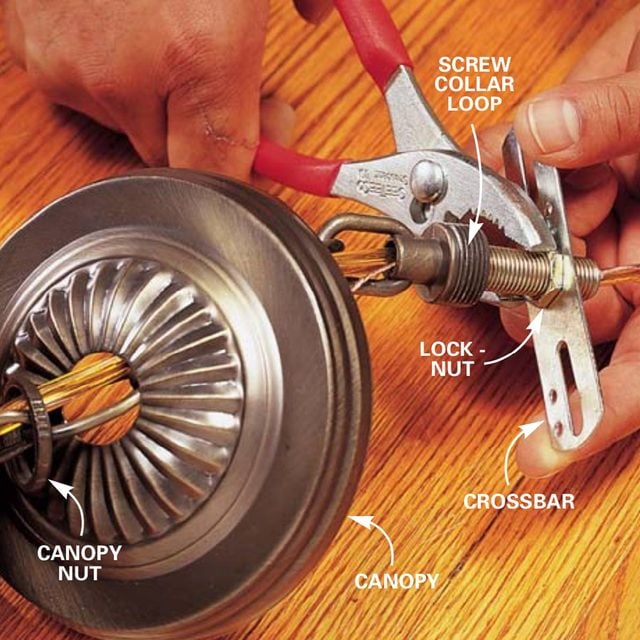
Align the back of the canopy (the side that fits against the ceiling) with the crossbar and adjust the length of the pipe until about 3/8 in. of the threads on the screw collar loop extend through the canopy. Lock the threaded pipe in this position by tightening the locknut against the crossbar.
You’ll save time and aching arms by assembling and adjusting the mounting hardware before you climb the ladder.
Note: The Additional Information at the end of this article below show the two most common mounting systems. In either case, the trick is to thread the machine screws or threaded rod into the crossbar first. Then slide the canopy over the screws or rod.
Align the crossbar with the back of the canopy and adjust the length of the screws or rod to protrude about 1/4 to 3/8 in. through the canopy. Tighten the locknut(s) to hold the screws or rod in this position. For hanging fixtures, adjust the length of the chain by removing lengths, but don’t cut the wires shorter until you’ve hung the fixture and confirmed that it’s the right height.
Mounting Systems
Whether your light fixture is held to the box with screws or a threaded pipe, the two mounting systems shown here, the key to an easy installation is assembling and adjusting the parts before you crawl up on the ladder. To do this, first thread the screws or pipe through the crossbar.
Then, while the fixture is still on the ground, line up the crossbar with the top of the canopy and adjust the screws or pipe in or out until about 1/4 to 1/2 in. is protruding through the canopy. Mount the crossbar to the electrical box, then connect the wires and finally the fixture (see “Mounting with Screws and Cap Nuts” and “Mounting with a Threaded Pipe” in Additional Information below).
Reconnect the Same Wires
Screw the Crossbar to the Box
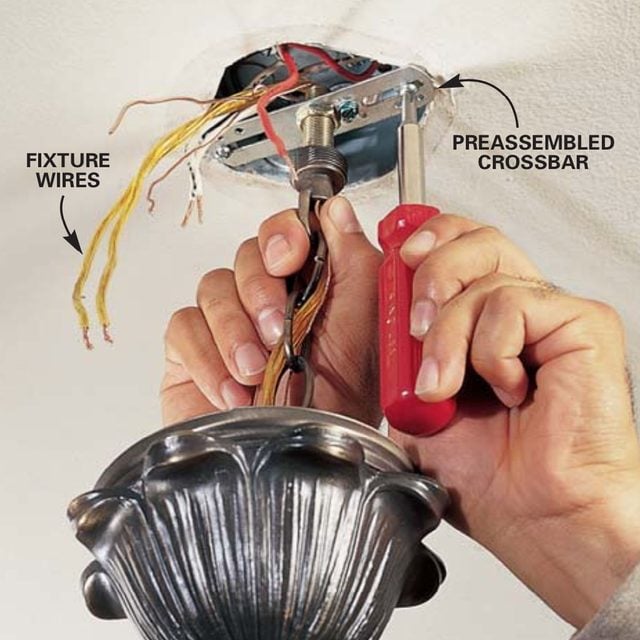
Position all the wires to one side of the crossbar. Then screw the crossbar to the electrical box with the screws. You’ll need a helper to support the fixture while you do this.
Connect the Wires
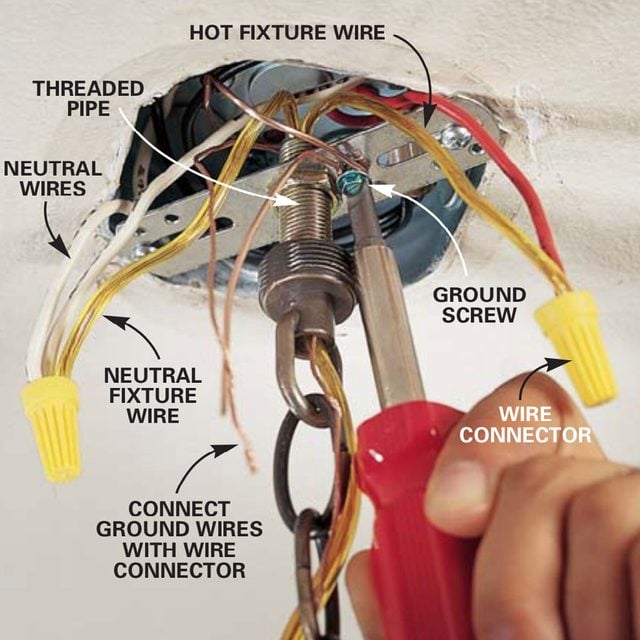
Connect the neutral wire from the light fixture to the neutral white wire(s) in the box. If your fixture is wired with lamp-style cord rather than white (neutral) and black (hot) wires, identify the neutral wire by looking for silver conductors, writing, squared corners, or ribs or indentations on the insulation.
The unmarked wire is the hot wire. Connect it to the colored (usually black or red) hot wire in the box. Complete the hook-up by looping the ground wire clockwise around the ground screw on the crossbar, tightening the screw, and connecting the end of the wire to the ground wire from the light fixture.
Close the Box
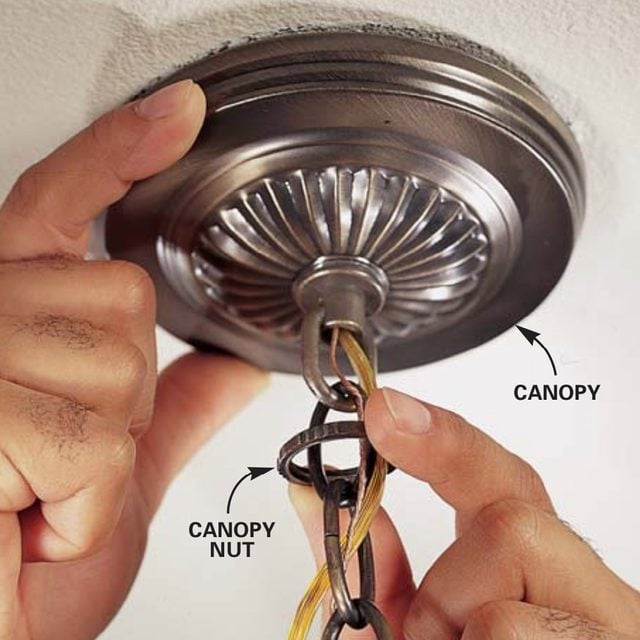
Fold the conductors into the ceiling box and slide the canopy over the protruding threaded support. Secure it with the decorative nut to complete the installation.
After testing to make sure none of the wires in the box are hot (Photo 2), disconnect the hot, neutral and ground (if your old fixture has one) from your old fixture and leave other wires bundled in the box. Reconnect the new fixture to these same wires (Photo 8).
If the old wires have twisted or damaged ends, cut them off and remove 1/2 in. of the insulated covering with a wire-stripping tool. Connect the wires from the new fixture with appropriately sized wire connectors. Read the packaging to determine the correct size. When you connect stranded fixture wire to solid wire, extend the stranded end about 1/8 in. beyond the solid wire before you twist on the wire connector. Stranded wire occasionally clogs the threads in a connector, preventing a tight grip. Discard the connector and use a new one if it spins freely without tightening.
Complete the installation by installing the canopy (Photo 9). If it doesn’t fit tight to the ceiling, readjust the screws or threaded rod. Add light bulbs, switch on the power, and turn on the switch to check out your work.
CAUTION!
If you have aluminum wiring, don’t mess with it! Call in a licensed pro who’s certified to work with it. This wiring is dull gray, not the dull orange that’s characteristic of copper.



















